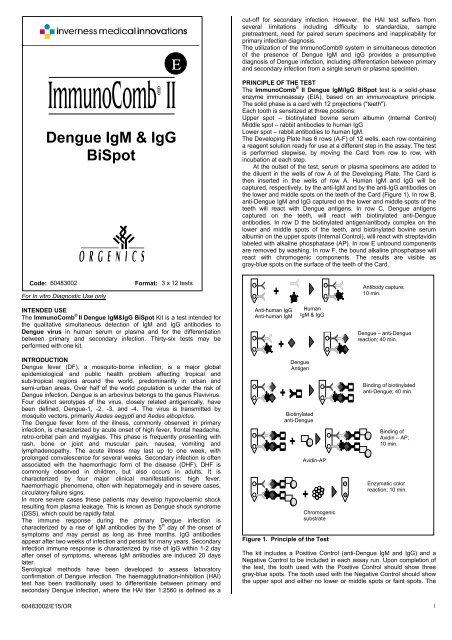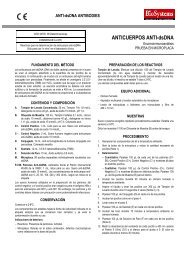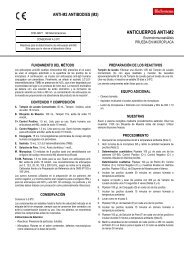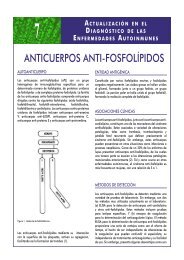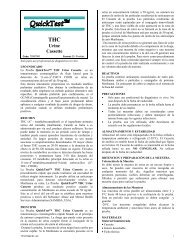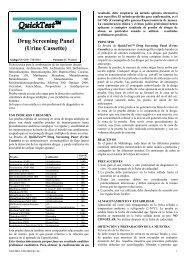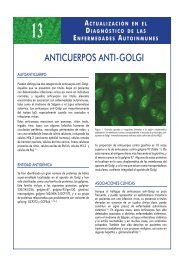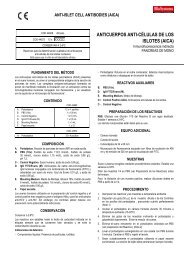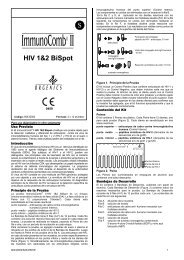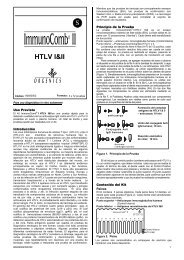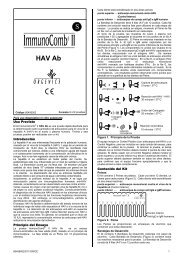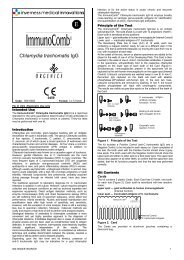Dengue IgM & IgG BiSpot
Dengue IgM & IgG BiSpot
Dengue IgM & IgG BiSpot
You also want an ePaper? Increase the reach of your titles
YUMPU automatically turns print PDFs into web optimized ePapers that Google loves.
cut-off for secondary infection. However, the HAI test suffers fromseveral limitations including difficulty to standardize, samplepretreatment, need for paired serum specimens and inapplicability forprimary infection diagnosis.The utilization of the ImmunoComb® system in simultaneous detectionof the presence of <strong>Dengue</strong> <strong>IgM</strong> and <strong>IgG</strong> provides a presumptivediagnosis of <strong>Dengue</strong> infection, including differentiation between primaryand secondary infection from a single serum or plasma specimen.<strong>Dengue</strong> <strong>IgM</strong> & <strong>IgG</strong><strong>BiSpot</strong>PRINCIPLE OF THE TESTThe ImmunoComb ® II <strong>Dengue</strong> <strong>IgM</strong>/<strong>IgG</strong> <strong>BiSpot</strong> test is a solid-phaseenzyme immunoassay (EIA), based on an immunocapture principle.The solid phase is a card with 12 projections ("teeth").Each tooth is sensitized at three positions:Upper spot – biotinylated bovine serum albumin (Internal Control)Middle spot – rabbit antibodies to human <strong>IgG</strong>Lower spot – rabbit antibodies to human <strong>IgM</strong>.The Developing Plate has 6 rows (A-F) of 12 wells, each row containinga reagent solution ready for use at a different step in the assay. The testis performed stepwise, by moving the Card from row to row, withincubation at each step.At the outset of the test, serum or plasma specimens are added tothe diluent in the wells of row A of the Developing Plate. The Card isthen inserted in the wells of row A. Human <strong>IgM</strong> and <strong>IgG</strong> will becaptured, respectively, by the anti-<strong>IgM</strong> and by the anti-<strong>IgG</strong> antibodies onthe lower and middle spots on the teeth of the Card (Figure 1). In row B,anti-<strong>Dengue</strong> <strong>IgM</strong> and <strong>IgG</strong> captured on the lower and middle spots of theteeth will react with <strong>Dengue</strong> antigens. In row C, <strong>Dengue</strong> antigenscaptured on the teeth, will react with biotinylated anti-<strong>Dengue</strong>antibodies. In row D the biotinylated antigen/antibody complex on thelower and middle spots of the teeth, and biotinylated bovine serumalbumin on the upper spots (Internal Control), will react with streptavidinlabeled with alkaline phosphatase (AP). In row E unbound componentsare removed by washing. In row F, the bound alkaline phosphatase willreact with chromogenic components. The results are visible asgray-blue spots on the surface of the teeth of the Card.Code: 60483002For In vitro Diagnostic Use onlyFormat: 3 x 12 testsAntibody capture;10 min.INTENDED USEThe ImmunoComb ® II <strong>Dengue</strong> <strong>IgM</strong>&<strong>IgG</strong> <strong>BiSpot</strong> Kit is a test intended forthe qualitative simultaneous detection of <strong>IgM</strong> and <strong>IgG</strong> antibodies to<strong>Dengue</strong> virus in human serum or plasma and for the differentiationbetween primary and secondary infection. Thirty-six tests may beperformed with one kit.Anti-human <strong>IgG</strong>Anti-human <strong>IgM</strong>Human<strong>IgM</strong> & <strong>IgG</strong><strong>Dengue</strong> – anti-<strong>Dengue</strong>reaction; 40 min.INTRODUCTION<strong>Dengue</strong> fever (DF), a mosquito-borne infection, is a major globalepidemiological and public health problem affecting tropical andsub-tropical regions around the world, predominantly in urban andsemi-urban areas. Over half of the world population is under the risk of<strong>Dengue</strong> infection. <strong>Dengue</strong> is an arbovirus belongs to the genus Flavivirus.Four distinct serotypes of the virus, closely related antigenically, havebeen defined, <strong>Dengue</strong>-1, -2, -3, and -4. The virus is transmitted bymosquito vectors, primarily Aedes aegypti and Aedes albopictus.The <strong>Dengue</strong> fever form of the illness, commonly observed in primaryinfection, is characterized by acute onset of high fever, frontal headache,retro-orbital pain and myalgias. This phase is frequently presenting withrash, bone or joint and muscular pain, nausea, vomiting andlymphadenopathy. The acute illness may last up to one week, withprolonged convalescence for several weeks. Secondary infection is oftenassociated with the haemorrhagic form of the disease (DHF). DHF iscommonly observed in children, but also occurs in adults. It ischaracterized by four major clinical manifestations: high fever,haemorrhagic phenomena, often with hepatomegaly and in severe cases,circulatory failure signs.In more severe cases these patients may develop hypovolaemic shockresulting from plasma leakage. This is known as <strong>Dengue</strong> shock syndrome(DSS), which could be rapidly fatal.The immune response during the primary <strong>Dengue</strong> infection ischaracterized by a rise of <strong>IgM</strong> antibodies by the 5 th day of the onset ofsymptoms and may persist as long as three months. <strong>IgG</strong> antibodiesappear after two weeks of infection and persist for many years. Secondaryinfection immune response is characterized by rise of <strong>IgG</strong> within 1-2 dayafter onset of symptoms, whereas <strong>IgM</strong> antibodies are induced 20 dayslater.Serological methods have been developed to assess laboratoryconfirmation of <strong>Dengue</strong> infection. The haemagglutination-inhibition (HAI)test has been traditionally used to differentiate between primary andsecondary <strong>Dengue</strong> infection, where the HAI titer 1:2560 is defined as a<strong>Dengue</strong>AntigenBiotinylatedanti-<strong>Dengue</strong>Avidin-APChromogenicsubstrateFigure 1. Principle of the TestBinding of biotinylatedanti-<strong>Dengue</strong>; 40 min.Binding ofAvidin – AP;10 min.Enzymatic colorreaction; 10 min.The kit includes a Positive Control (anti-<strong>Dengue</strong> <strong>IgM</strong> and <strong>IgG</strong>) and aNegative Control to be included in each assay run. Upon completion ofthe test, the tooth used with the Positive Control should show threegray-blue spots. The tooth used with the Negative Control should showthe upper spot and either no lower or middle spots or faint spots. The60483002/E15/OR 1
internal controls indicate that the kit has not been damaged duringupper spot should also appear on all other teeth, to confirm that the kit* Unless stored for documentation row A of the Developing Plate with the pipette tip or perforator andfunctions properly and that the test was performed correctly.transport.• Store the kit in its original box at 2-8 o C.KIT CONTENTS• Do not freeze the kit.CardsThe kit contains 3 plastic Cards. Each Card has 12 teeth, one tooth for• Following the first opening of the Kit the components have to bestored at 2-8 o C.each test (Figure 2). Each tooth is sensitized with two reactive areas:• Performance of the Kit after the first opening is stable up to theUpper spot – biotinylated bovine serum albumin (Internal Control)expiry date of the Kit, when stored at 2-8 o C.Middle spot – rabbit antibodies to human <strong>IgG</strong>• After first use, the card and plate cannot be used for more thanLower spot – rabbit antibodies to human <strong>IgM</strong>.three times.®ImmunoComb IIHandling of Specimens• You may test either serum or plasma.83 83 83 83 83 83 83 83 83 83 83 83• Specimens may be stored for 7 days at 2-8°C before testing. To storefor more than 7 days, freeze specimens at –20°C or colder.• All frozen specimens must be centrifuged at 10,000 g for 5 min atroom temperature. Carefully remove the test sample from theInternal Controlsupernatant. If a lipid layer is formed on the surface of the liquid,Anti-human <strong>IgG</strong>ensure that the sample is taken from the clear liquid below that layer.Anti-human <strong>IgM</strong>Avoid repeated freezing and thawing.Figure 2. Card• Anti coagulants such as heparin, EDTA and sodium citrate wereThe Cards are provided in aluminum pouches containing a desiccant bag.found to have no effect on the test results.Developing PlatesTEST PROCEDUREThe kit contains 3 Developing Plates covered with aluminum foil. EachEquipment NeededDeveloping Plate (Figure 3) contains all reagents needed for the test. The• Precision pipettes with disposable tips for dispensing 10 µl, 25 µlDeveloping Plate consists of 6 rows (A–F) of 12 wells each.and 100 µl• ScissorsThe contents of each row are as follows:Row A Specimen diluent• Laboratory timer or watchRow B <strong>Dengue</strong> antigens• Micro tubes, or microtiter well stripsRow C Biotinylated monoclonal antibody to <strong>Dengue</strong>proteinsPreparing the TestRow D Streptavidin conjugated to alkaline phosphataseBring all components, cards, reagents and specimens to roomRow E Washing solutiontemperature and perform the test at room temperature.Row F Chromogenic substrate solution containing5-bromo-4-chloro-3-indolyl phosphate (BCIP)Preparing the Developing Plateand nitro blue tetrazolium (NBT)1. Incubate the Developing Plate in an incubator at 37°C for30 minutes; or leave at room temperature (22-26°C) for 3 hours.2. Cover the worktable with absorbent tissue to be discarded asbiohazardous waste at the end of the test.3. Mix reagents by inverting the Developing Plate a few times.Note: Do not remove the foil cover of the Developing Plate. Break thefoil cover by using the disposable tip of the pipette or the perforator onlywhen instructed to do so by the Test Instructions.Preparing the CardFigure 3. Developing PlateCaution: To ensure proper functioning of the test, do not touch theteeth of the Card.1. Tear the aluminum pouch of the Card at the notched edge. Removethe Card.Positive Control – 1 vial (red-colored cap) of 0.15 ml diluted human heatinactivatedplasma, containing anti-<strong>Dengue</strong> <strong>IgM</strong> and <strong>IgG</strong> antibodies.Negative Control –1 vial (green-colored cap) of 0.15 ml dilutedheat-inactivated reconstituted human plasma, negative for antibodies to<strong>Dengue</strong> virus.CombScale – for reading test resultsPerforator – for perforation of the aluminum foil, covering the wells of theDeveloping Plate.2. You may use the entire Card and Developing Plate or only a part.To use part of a Card:a. Determine how many teeth you need for testing the specimensand controls. You need one tooth for each test. Each toothdisplays the code number "83" of the kit, to enable identificationof detached teeth.b. Bend and break the Card vertically or cut with scissors(see Figure 4) to detach the required number of teeth (No. oftests including 2 controls).SAFETY AND PRECAUTIONSc. Return the unused portion of the Card to the aluminum pouch• Human source materials used in the preparation of the kit weretested and found to be non-reactive for hepatitis B surface antigen,and for antibodies to HIV and to HCV. Since no test method can givecomplete assurance of the absence of viral contamination, allreference solutions and all human specimens should be handled aspotentially infectious.(with desiccant bag). Close pouch tightly, e.g. with a paperclip, to maintain dryness. Store the Card in the original kit box at2°–8°C for later use.ImmunoComb ®• Wear surgical gloves and laboratory clothing. Follow accepted laboratoryprocedures for working with human serum or plasma.83 83 83 83 83 83 83 83 83 83 83 83• Do not pipette by mouth.• Dispose of all specimens, used Cards * , Developing Plates, and othermaterials used with the kit as biohazardous waste.• Do not mix reagents from different lots.• Do not use kit after the expiry date.STORAGE AND STABILITY OF THE KITFigure 4. Breaking the Card• The kit is shipped at 2-8 o C. During transport the kit can be keptat ≤ 30 o C for short time periods not exceeding a total of 48 hours. The TEST INSTRUCTIONSAntibody Capture (Row A of the Developing Plate)1. Pipette 10 μl of specimen. Perforate the foil cover of one well of60483002/E15/OR 2
dispense the specimen at the bottom of the well. Mix by repeatedlyrefilling and ejecting the solution. Discard pipette tip.2. Repeat step 1 for the other specimens and the two controls. Use anew well in row A and change pipette tip for each specimen orcontrol.3. a. Insert the Card (printed side facing you) into the wells of row Acontaining specimens and controls.Mix: Withdraw and insert the Card in the wells several times.b. Leave the Card in row A and incubate for 10 minutes at roomtemperature. Set the timer. Near the end of 10 minutes,perforate the foil of row B using the perforator. Do not openmore wells than needed.c. At the end of 10 minutes, take the Card out of row A.Absorb adhering liquid from the pointed tips of the teeth onclean absorbent paper. Do not touch the front surface of theteeth.Antigen-Antibody reaction (Row B)4. Insert the Card into the wells of row B. Mix as in step 3a. IncubateDeveloping Plate with Card for 40 minutes (set timer) at roomtemperature. Perforate the foil of row C. After 40 minutes,withdraw the Card and absorb adhering liquid as in step 3c.Binding of Biotinylated anti-<strong>Dengue</strong> (Row C)5. Insert the Card into the wells of row C. Mix as in step 3a. IncubateDeveloping Plate with Card for 40 minutes (set timer) at roomtemperature. Perforate the foil of row D. After 40 minutes,withdraw the Card and absorb adhering liquid.Binding of modified avidin/alkaline phosphatase (Row D)6. Insert the Card into the wells of row D. Mix. Incubate DevelopingPlate with Card for 10 minutes (set timer) at room temperature.Perforate the foil of row E. After 10 minutes, withdraw the Card andabsorb adhering liquid.First Wash (Row E)7. Insert the Card into the wells of row E. Agitate: Vigorously withdrawand insert the Card in the wells for at least 10 seconds to achieveproper washing. Repeat agitation several times during the course of2 minutes; meanwhile perforate the foil of row F. After 2 minutes,withdraw the Card and absorb adhering liquid.Color Reaction (Row F)8. Insert the Card into the wells of row F. Mix. Incubate theDeveloping Plate with the Card for exactly 10 minutes (set timer) atroom temperature. After 10 minutes, withdraw the Card.Stop Reaction (Row E)9. Insert the Card again into row E.After 1 minute, withdraw the Card and allow it to dry in the air.Waste DisposalDispose of used Developing Plates, pipette tips, micro tubes or microtiterwell strips, absorbent paper, and gloves as biohazardous waste.STORING UNUSED PART OF KITDeveloping PlateIf you have not used all the wells of the Developing Plate, you may store itfor future use:• Seal used wells with wide adhesive tape so that nothing can spillout of the wells, even if the Developing Plate is tipped over.Other Kit Materials:• Return remaining Developing Plate(s), Card(s), perforator,controls, specimen diluent, and instructions to the original kit box.Store at 2-8°C.TEST RESULTSValidationIn order to confirm that the test functions properly and to demonstratethat the results are valid, the following three conditions must be fulfilled(see Figure 5):1. The Positive Control must produce three spots on the Card tooth.2. The Negative Control must produce an upper spot(Internal Control). The lower and the middle spot will either notappear or appear faintly, without affecting the interpretation of theresults.3. Each specimen tested must produce an upper spot(Internal Control).If any of the three conditions are not fulfilled, the results are invalid, andthe specimens and controls should be retested.PositiveControlNegativeControlInvalidResultsFigure 5. Test ValidationREADING AND INTERPRETATION OF THE RESULTSVisual Interpretation of <strong>Dengue</strong> <strong>IgM</strong>Compare the intensity of the lower spot of each specimen tooth withthat of the lower spot of the Positive Control tooth (Figure 6).• A spot with intensity higher than or equal to that of the positivecontrol indicates a positive result for the specimen.• No spot or a spot with intensity lower than that of the PositiveControl indicates the absence of anti-<strong>Dengue</strong> <strong>IgM</strong> antibodies inthe specimen (Negative Result).• Equivocal samples should be retested. If the interpretation remainsequivocal, then a new sample must be collected.NegativeResult
Summary of results interpretation<strong>IgM</strong>ColorResultIntensity<strong>IgG</strong>ColorResultIntensity0 Negative < CO* NegativeProposed InterpretationNo evidence for <strong>Dengue</strong>infectionPositive predictive value (PPV):For <strong>IgG</strong>: 91.4%.For <strong>IgM</strong>: 91.4%.Negative predictive value (NPV):For <strong>IgG</strong>: 100%.For <strong>IgM</strong>: 96.8%.> 0and< C+_________*CO=Cut-OffGrayZone< C+ Negative< CO* Negative≥CO*and
Summary of Main Test Procedures1 2 3 4Bring the Developing Plate to roomDrawing specimens and Adding specimens and Removing Card fromtemperature: 30 minutes at 37°C.controls.controls to row A. pouch.5 6 7 8Insert Card in row A and mix.Incubate at RT.Open row B.Absorb adhering liquidfrom teeth.Insert Card and agitatein row B. Incubate.After mixing/agitating& incubating in rowsC, D and E …9 10Color reaction in row F.ResultsSUMMARY OF THE TEST PROCEDUREThe abbreviated instructions below are for experienced users of the ImmunoComb ® II<strong>Dengue</strong> <strong>IgM</strong>&<strong>IgG</strong> <strong>BiSpot</strong> Kit.(For detailed instructions please refer to complete text inside)1. Bring all reagents and specimens to room temperature and perform the test at room temperature.2. Dispense 10 µl of each specimen and controls into the wells of row A of the Developing Plate.3. Insert Card in row A, mix, and continue as described in Table 1.Table 1. Summary of test procedureStep Row Proceed as followsAntibody capture A Mix; incubate 10 minutes; absorb.Antigen-antibody reaction B Mix; incubate 40 minutes; absorb.Binding of biotinylated anti-<strong>Dengue</strong> C Mix; incubate 40 minutes; absorb.Binding of modified avidin/ alkaline phosphatase D Mix; incubate 10 minutes; absorb.Wash E Agitate; incubate 2 minutes; absorb.Chromogen F Mix; incubate 10 minutes.Stop reaction E Incubate 1 minute; dry in air.1Bending and breakingthe Card260483002/E15/OR 5


